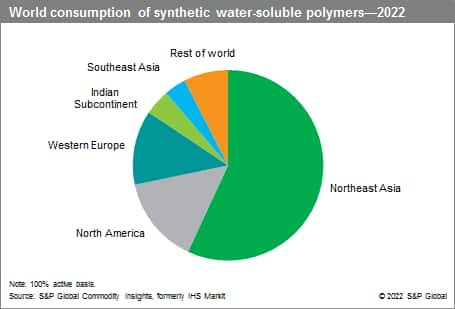Published August 2022
Synthetic water-soluble polymers are organic materials that dissolve, disperse, or swell in water and thus modify the physical properties of the resulting aqueous system. These macromolecules act as dispersants, suspending agents, thickeners, stabilizers, coagulants, flocculants, film-formers, binders, humectants, and lubricants in aqueous media. In addition, some water-soluble polymers serve as starting materials for other products.
The following pie chart shows world consumption of synthetic water-soluble polymers in 2022:

Northeast Asia—mainland China, Japan, South Korea, and Taiwan—was the leading global consumer of synthetic water-soluble polymers, followed by North America and Western Europe. With regard to consumption growth, the Indian Subcontinent is the fastest-growing market, followed by Northeast Asia and Southeast Asia and Oceania. Consumption in North America and Western Europe is predicted to grow at a slower pace because of the maturity of large traditional applications such as water treatment, paper production, detergents, and textile processing.
Synthetic water-soluble polymers are employed in a wide range of applications. No single end use dominates the consumption of water-soluble polymers as a class; major applications vary from polymer to polymer. Large volume industrial applications include municipal and industrial water treatment, paper manufacture, mineral processing, oil and gas production, textile processing, detergents, adhesives, surface coatings, and construction materials. Synthetic water-soluble polymers also find application in consumer goods such as personal care products, cosmetics, and pharmaceuticals.
Growth in the consumption of synthetic water-soluble polymers is generally aligned with regional growth expectations for the relevant end-use industries. At a more granular level, demand for synthetic water-soluble polymers is affected by performance relative to competing materials and product trends within specific end uses.
For more detailed information, see the table of contents, shown below.
S&P Global’s Chemical Economics Handbook – Water-Soluble Polymers, Synthetic is the comprehensive and trusted guide for anyone seeking information on this industry. This latest report details global and regional information, including

Key Benefits
S&P Global’s Chemical Economics Handbook – Water-Soluble Polymers, Synthetic has been compiled using primary interviews with key suppliers and organizations, and leading representatives from the industry in combination with S&P Global’s unparalleled access to upstream and downstream market intelligence and expert insights into industry dynamics, trade, and economics.
This report can help you
- Identify trends and driving forces influencing chemical markets
- Forecast and plan for future demand
- Understand the impact of competing materials
- Identify and evaluate potential customers and competitors
- Evaluate producers
- Track changing prices and trade movements
- Analyze the impact of feedstocks, regulations, and other factors on chemical profitability


















